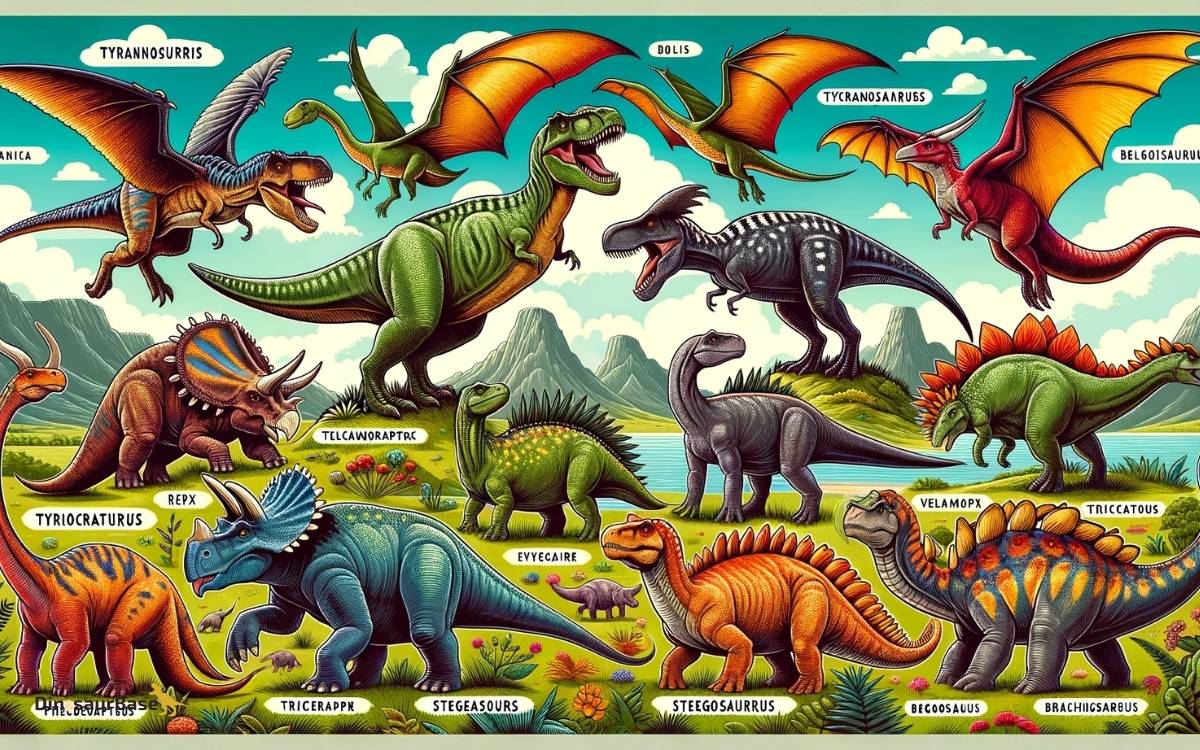Exploring Prehistory: Some Dinosaur Names You Should Know
Tyrannosaurus Rex, Velociraptor, and Triceratops are iconic dinosaur names all enthusiasts should recognize. The Brachiosaurus and Stegosaurus also rank highly among these prehistoric giants.
Delving into the vast and ancient world of dinosaurs is an exciting journey through Earth’s history. These creatures, which dominated the terrestrial landscapes for over 160 million years, continue to capture our imagination.
Common names like Tyrannosaurus Rex evoke images of the ferocious predator that roamed North America, while Velociraptor brings to mind the swift and intelligent hunters.
The gentle giants, such as Brachiosaurus, tell tales of enormous herbivores towering above the forests, and the armored Stegosaurus highlights the diverse adaptations of these creatures.
Knowledge of these names not only enriches our understanding of the prehistoric past but also enhances the cultural lexicon surrounding paleontology.
Exploring these names provides a window into an age when dinosaurs reigned supreme, offering invaluable insights into the evolution and diversity of life on Earth.

The Fascination With Dinosaurs
The allure of dinosaurs extends far beyond their massive skeletons housed in museums worldwide.
These prehistoric giants captivate the imagination, offer insights into the Earth’s past, and fuel scientific discovery.
Exploring their world teaches us about evolution, adaptation, and the dynamics of our planet’s ecosystems as they existed millions of years ago.
Dinosaurs evoke awe and curiosity in people of all ages. Their towering presence and mysterious extinction spark questions and narratives.
Blockbuster movies, children’s literature, and toys help keep these ancient creatures at the forefront of popular culture.
Cultural Impact
Dinosaurs reign supreme in the kingdom of imagination. They inhabit the realms of both science and myth, inspiring tales of adventure and caution.
- Movies and Television: Dinosaurs take center stage in films like Jurassic Park, igniting the public’s passion for these ancient beasts.
- Books and Comics: From educational texts to graphic novels, dinosaurs fill pages with facts and fiction.
- Games and Toys: Figurines and video games allow fans to recreate dinosaur worlds.
Scientific Significance
Dinosaur discoveries drive scientific inquiry. They offer clues about Earth’s geological past. Paleontologists study these creatures to understand life’s resilience and diversity.
| Fossil Finds | Contributions |
|---|---|
| Tyrannosaurus Rex | Insights into predator behavior |
| Stegosaurus | Information on plate arrangement and defense |
| Velociraptor | Evidence of social hunting patterns |
These findings stimulate educational programs and encourage new generations to pursue careers in science.

Credit: www.marylandzoo.org
Classifying The Titans Of Prehistory
Step back in time to the age of the dinosaurs, a period where gigantic creatures roamed the Earth. The titans of prehistory were as varied as they were magnificent.
To understand these beasts, we classify them by diet, size, and habitat. Let’s dig deeper into the fascinating world of dinosaurs and some of their well-known names.
Herbivores Versus Carnivores
Dinosaurs came in two main diets: plant-eaters and meat-eaters. Each had unique features suited to their lifestyle.
- Herbivores: Gentle giants like Triceratops and Stegosaurus. They had flat teeth for grinding plants.
- Carnivores: Fierce hunters like Tyrannosaurus Rex and Velociraptor. They had sharp teeth and claws.
Size And Habitat Differentiation
Dinosaurs lived everywhere, from lush forests to dry deserts. Their size often linked to their home.
| Habitat | Size | Examples |
|---|---|---|
| Forests | Large | Brachiosaurus, Diplodocus |
| Plains | Medium to Large | Triceratops, Iguanodon |
The Famous Three: Tyrannosaurus Rex, Triceratops, And Velociraptor
Prehistoric creatures stir the imagination of both kids and adults. Dinosaurs are the stars of an era long gone.
Many dinos are well-known, yet three remain iconic: Tyrannosaurus Rex, Triceratops, and Velociraptor.
These fascinating dinosaurs roamed the Earth millions of years ago. They still capture our hearts today. Let’s take a closer look at these three incredible creatures.
Tyrannosaurus Rex: The Tyrant King
The Tyrannosaurus Rex, or T-Rex, dominated its territory. It was one of the most feared predators.
With its massive head, sharp teeth, and strong legs, T-Rex was a force to be reckoned with. Kids love this dino for its frightening reputation. Think of it as the ancient king of the dinosaurs.
- Height: Up to 20 feet tall
- Length: Up to 40 feet long
- Weight: Up to 8 tons
Triceratops: The Three-horned Giant
With its iconic three horns, the Triceratops is a dinosaur many can recognize. Its large frill and beak-like mouth were trademarks.
Triceratops stood its ground against predators. These gentle giants plucked plants with their strong beaks.
| Height | Length | Weight |
|---|---|---|
| 9.5 feet | 30 feet | 6-12 tons |
Velociraptor: The Clever Predator
Velociraptor means ‘swift thief’. These small but smart hunters worked in packs. They were about the size of a turkey. They had large claws on their feet. The Velociraptor was a master of surprise attacks. It showed great intelligence and agility.
- Height: Up to 1.6 feet at the hip
- Length: Up to 6.8 feet
- Weight: Around 33 pounds
Giants Of The Sky And Sea
Imagine a time when colossal creatures ruled the earth and seas. The Giants of the Sky and Sea were real and incredible. These beasts included the soaring pterosaurs and the fearsome marine reptiles.
We’re diving into a world where these creatures aren’t just a figment of imagination but a window into our planet’s formidable past.
Pterosaurs: Rulers Of The Skies
Pterosaurs soared above the land, dominating the prehistoric skies. Though not dinosaurs, their grace and size evoke awe.
These winged reptiles came in various shapes and sizes. Some had wingspans as wide as small planes. Let’s meet a few notable ones:
- Pteranodon – With a wingspan up to 7 meters, it’s one of the most recognizable pterosaurs.
- Quetzalcoatlus – Named after an Aztec deity, it had a wingspan up to 10 meters, making it one of the largest known flying creatures ever.
- Rhamphorhynchus – Known for its long tail and diamond-shaped vane at the end, Rhamphorhynchus was smaller but no less fascinating.
Marine Reptiles: Predators Beneath The Waves
Not all prehistoric giants took to the skies; many ruled the depths. Marine reptiles were versatile predators in ancient oceans.
Here’s a spotlight on some of the mighty rulers of the deep:
| Name | Description | Size |
|---|---|---|
| Icthyosaurus | Sleek, dolphin-like hunters with sharp teeth. | Up to 2 meters |
| Plesiosaurus | Long-necked creatures with paddle-like flippers. | Up to 15 meters |
| Mosasaurus | Massive, serpent-like with powerful jaws. | Up to 17 meters |
Each of these prehistoric giants has a story etched into the annals of the Earth’s history. They throw open a portal to a past that is both enigmatic and fascinating. Their names ring through the halls of natural history as icons of an age lost to time.
Herbivorous Behemoths
Dinosaurs roamed Earth millions of years ago. Among them were the herbivorous behemoths. With their massive size, these plant eaters ruled the ancient landscapes. Let’s meet some of these gentle giants who thrived on prehistoric greens.
Brachiosaurus: Towering Above the Trees
Brachiosaurus: Towering Above The Trees
The Brachiosaurus stood tall with its long neck stretching towards the sky. This dinosaur could reach leaves high up in trees like no other. It was one of the largest to walk our planet.
- Height: Up to 13 meters (43 feet)
- Weight: Up to 56 tonnes (62 US tons)
- Period: Late Jurassic
Stegosaurus: The Spiked and Plated Herbivore
Stegosaurus: The Spiked And Plated Herbivore
Stegosaurus, known for its row of bony plates and sharp tail spikes, was a sight to behold. Its armor helped it stay safe from predators while it munched on low-lying plants.
| Feature | Description |
|---|---|
| Plates | 17 along its back |
| Tail Spikes | 4, used as defense tools |
| Period | Late Jurassic |
Bringing Dinosaurs To Life
Dinosaurs once roamed our planet. Their vast and mysterious world attracts many. Today, we are uncovering secrets they left behind.
This journey takes us through exciting fossil discoveries and reconstructions. It helps us understand extinct species with the help of paleontology. Let’s dive into how we bring these fascinating creatures to life.
Fossil Discoveries and Reconstructions
Fossil Discoveries And Reconstructions
Fossil discoveries are like nature’s time capsules. They give us a glimpse of prehistoric life. Each fossil discovery adds a piece to the great puzzle of our planet’s history.
- Tyrannosaurus Rex: Unearthed in North America, the hunter of its time.
- Triceratops: Found with its iconic horns, a herbivore we all recognize.
- Velociraptor: The smaller but cunning cousin of the T. rex.
Scientists use fossils to reconstruct these ancient beasts. They piece together bones to craft full skeletons.
Life-size models emerge from the dust of bones. Museums proudly display these reconstructions, allowing us to walk with dinosaurs.
The Role Of Paleontology In Understanding Extinct Species
Paleontology is key to learning about dinosaurs. It is the science that studies ancient life through fossils.
Here’s how paleontologists work:
- They dig up fossilized bones.
- Experts examine and date these relics.
- They consider the habitat where dinosaurs lived.
Through detailed work, past ecosystems come to life. Paleontology not only uncovers bones. It also finds clues about dinosaur diets, behaviors, and how they may have looked. This field helps us appreciate the diverse life from millions of years ago.
Frequently Asked Questions Of Exploring Prehistory: Some Dinosaur Names You Should Know
What Are 17 Letter Dinosaur Names?
Some 17-letter dinosaur names include Micropachycephalosaurus and Pararhabdodonispanyensis. These long-named dinosaurs showcase the diversity of prehistoric life.
What’s The Coolest Dinosaur Name?
The coolest dinosaur name is often considered to be the Velociraptor, known for its speed and appearance in popular culture.
What Are 23 Letter Dinosaur Names?
Micropachycephalosaurus is a 23-letter dinosaur name, belonging to a small herbivore from the Late Cretaceous period.
What Are The Names Of The Different Dinosaurs?
Some well-known dinosaur names include Tyrannosaurus Rex, Velociraptor, Triceratops, Stegosaurus, and Brachiosaurus. Each represents a unique genus within the diverse group of prehistoric reptiles.
Conclusion
Embarking on a journey through prehistoric times is truly fascinating. Knowing the names of dinosaurs like Tyrannosaurus Rex, Velociraptor, and Triceratops connects us to Earth’s ancient history.
Remember these giants as you explore the past, armed with knowledge that’s both engaging and enlightening.
Let’s keep the curiosity alive for generations to come!




